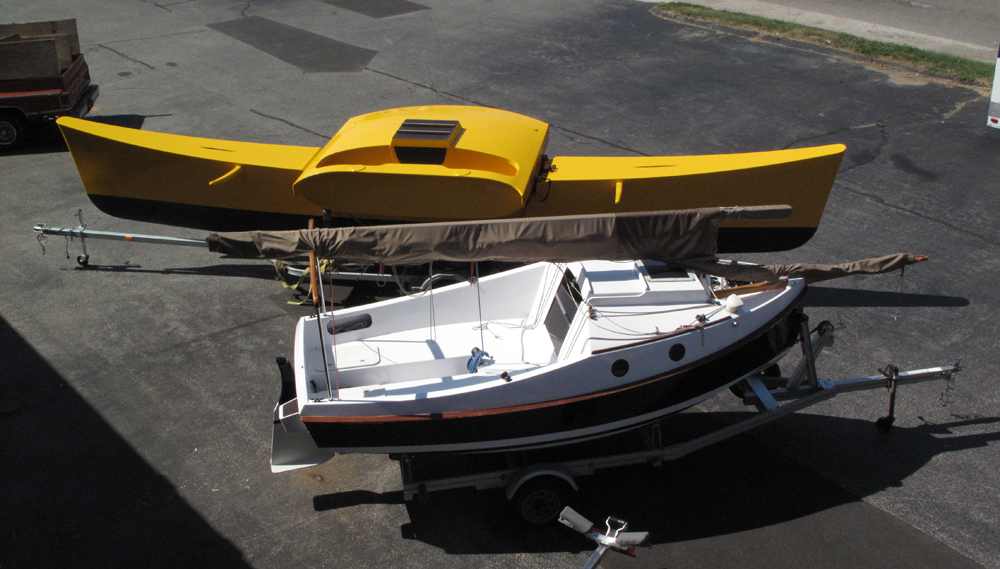>>>>I'm wanting a heavier boat as getting into one from my dock is difficult with a light weight boat bouncing around whilst getting a footing in the center.
>>>>>
This is a GREAT question with relevance to anyone contemplating the handling qualities of small boats.
For the TL:DR crowd, the bottom line: It's okay to build the Skerry heavier, and yes it'll dampen the boat's motion a little. But you'd have to make it surprisingly heavy to make a real difference.
For the devoted readers:
One of the presentations I've given many times is entitled "The Design of Small Cruising Boats." One of the central themes is my effort to get people to decouple "length" and "size" when pondering the qualities of a given design, and instead to focus on hull weight and the waterline length. Length is NOT size. Hull weight and waterline length tell you more about a boat's handling characteristics than any other number. "LOA" can be very deceiving.
LOA is "length overall." The fixation on LOA as a primary descriptor for a boat dates to the explosion of pleasure boat marketing post-WWII, when being a foot longer than the competition could sell a boat. Prior to the 1950's, it was common to read an entire article about a boat and the LOA not be mentioned once, only the boat's weight or waterline length.
Perfect example: PocketShip and Madness. PocketShip is 14'10" on deck, and Madness is 31'0" on deck. Rigged and afloat, both weigh almost exactly the same, within a few pounds. But their handling properties couldn't be any more different! Describing one boat as a 15-footer and the other as a 31-footer, therefore, tells you essentially nothing about their qualities as boats.

I bring this up because when many people visualize the Skerry as a 15-foot sailboat, their mind calls up for comparison a list of all the 15-footers they have known. If a 15-foot Boston Whaler comes to mind (statistically likely), that's a boat with a dry weight of around 1,255 pounds. Stepping aboard a Boston Whaler Montauk 150 feels very much like stepping onto a floating dock. The Skerry, on the other hand, rigged for sail and with some equipment aboard, doesn't weigh more than 120 pounds soaking wet. Some dogs weigh more. Though it shares its LOA with the Boston Whaler, the Skerry is closer to a canoe than to the Boston Whaler.
The physical principle at work is the moment of inertia. The Skerry's low polar moment of inertia means it's going to have a "quick" motion when you move around in it. A 180-pound crew will outweigh the boat, and they'll need to mind where they're stepping or sitting to keep the boat in trim. The upshot of being a light craft is that the Skerry is fast under oars or sail and easy to manage ashore. But it won't be as easy to move around in as the Boston Whaler, or the Peeler Skiff, or PocketShip.
So, building a heavier Skerry will take some of the quickness out of its motion. How much heavier does it need to be to make a noticeable difference? Quite a lot. Making it as heavy as the Peeler Skiff (320 pounds or so) would help, though one reason the Peeler Skiff is so stable and solid is that it's wide at the waterline. (The heavier Skerry will still have a relatively narrow waterline, the same quality that makes it so easily-driven under oars or sail.) I doubt making the Skerry 30 or 40 pounds heavier will create a huge difference in stepping aboard from a dock. My experience is that you don't get to be indifferent about how you move about in a small boat until you're up over 600 pounds of dry hull weight.
Also (and this is important): Subtract any addition to the Skerry's dry weight from the Skerry's safe payload. If a stock Skerry has a payload of 450 pounds, a 300-pound Skerry will have a payload of 270 pounds.
In general I'd endorse a heavier Skerry. Once you pass the weight threshold for singlehanded cartopping (about 55 pounds), and then pass the threshold for cartopping with two strong adults (about 110 pounds), then you're going to be trailering the boat. Once you're trailering, the threshold for easy handling soars into the thousands of pounds, so other than the loss of payload you aren't really paying much of a penalty. The difference in speed won't be very noticeable, at least under sail, since the Skerry isn't a planing boat.
Once in awhile someone asks about ballasting the Skerry. For example, adding a slug of lead to the daggerboard. Again, in order to actually make a noticeable difference you're going to have to add a LOT of weight. Hundreds of pounds, realistically. 30 pounds in the daggerboard will do nothing but rick your back when you try to lift it out of the trunk. The Skerry doesn't have enough built-in flotation to deal with a lead keel or much ballast. One ponders water ballast, but you'd really want to start out with a bigger, deeper hull, so that you don't erase the subject boat's payload.
The stock Skerry is a terrific, sporty little rowing/sailing boat. Personally I wouldn't change a thing. Building it heavier, adding floorboards and so on, won't hurt much and may make it slightly more tractable dockside. But you might want to ponder building the slightly larger Northeaster Dory. It's still a light boat, but its greater waterplane area means it's more stable right out of the box.



